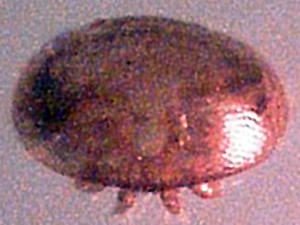 You non-beekeepers out there probably get bored out of your minds by my constant discussions of the ways of mites and men, but perhaps this picture might make the point. The nightmarish bug above, which looks like a hairy-legged lentil at 60 times magnification, is actually a varroa mite — a critter that lives to for two purposes: to suck the life out of developing bees, and then make more of itself. It's not much more than a grasping mouth and reproductive system with a poorly thought out transportation arrangement.
You non-beekeepers out there probably get bored out of your minds by my constant discussions of the ways of mites and men, but perhaps this picture might make the point. The nightmarish bug above, which looks like a hairy-legged lentil at 60 times magnification, is actually a varroa mite — a critter that lives to for two purposes: to suck the life out of developing bees, and then make more of itself. It's not much more than a grasping mouth and reproductive system with a poorly thought out transportation arrangement. This is the bug, actually an arachnid, that you heard about on the news, or NPR or the paper. It killed about 60% of the honeybees in California last winter, and is the reason why feral honeybees (ones that don't have beekeepers) basically exist no longer in this country. The current rumor is that it jumped to honeybees from some other host bee by travelling to this country in a bouquet of cut flowers. Folks around here like to blame Florida, saying it's the most probable point of entry (since so many other invasive critters and plants got in that way), but it must be said that there is now almost nowhere in the world without the nasty varroa mite.
This is the reason why many beekeepers gave up the hobby in the past 15-20 years: it is a hard and heartbreaking fight. The medications can be rude, over not-very-much time drug resistance grows, and then you need to use something else. Me, I am using an approach that only just got approved in all the surrounding states, and it is less toxic but much more work. And on Sunday, when weather and the instructions and my conscience dictated I had to go in, round two of the anti-varroa labor took place.
My order of operations, for both colonies, was:
- Attempt to block view from nosy neighbors by deploying deck umbrella on its side (as if I was trying to dry it out);
- Open hive top, check on syrup consumption in feeder;
- Remove feeder and 2-3 supers of honey, cover with cloths to prevent robbing. Give a quick look to see if stores were still adequate;
- Once down to the brood level, pick out and set aside the first packets of ApiLife VAR. Take new packets out of baggy, and set in four corners above brood;
- Reassemble; and
- In an unplanned brain wave, check out the contents of the bottom boards below the hives.
The good thing is that I got lots of pictures this time (and you can see them via the link at right). The bad thing is that my wifty hopes that maybe I did not actually have an infestation got kicked around by the evidence of mite death you can see already. That's how I got the picture above: fishing dead mites from beneath the colonies (in this case, from Wilde).
This is yet another occasion where, being a beginner, I am not totally sure what I am seeing, and it will be hard to look up some kind of reliable reference point for comparison. You usually estimate your mite count by conducting a special test of mite drop over a few days onto a clean surface, or by doing something called a "sugar roll." I used the bottom board test, but knew I would treat anyway because my bees are under stress and I am error prone. It just seemed safer.
Sunday's information would not constitute much of a mite population count. Happening upon dead mites — over an indeterminate amount of time, on a cluttered work surface, after getting partway through a cycle of treatment — won't tell you many specifics...but you will know that they were there.
Therefore I am glad to be going through the bother of putting together meds, taking apart colonies, and fussing over the girls. I checked to see if they had slurped up their 2:1 syrup with the Nosema meds (yes), whether there was an evidence of robbing (no), and what seemed to be occupying them most (bringing in pollen). The bees were not aggressive at all, but I still kept my gloves on because I had to handle meds.
Today, when I went up on the roof (in the 53 degree F rain) the girls were all inside, no bees flying at all. Originally, I'd hoped to do the work today, and to have my friend Kim and her mom stop by to both help and get a look (there is some chance that I'd get a beevangelical convert out of this, I thought). Looking at the weather, next Monday would be my best timed shot, if the temp is high and the sky is dry.
No comments:
Post a Comment